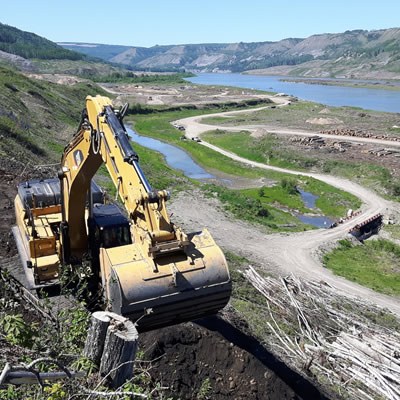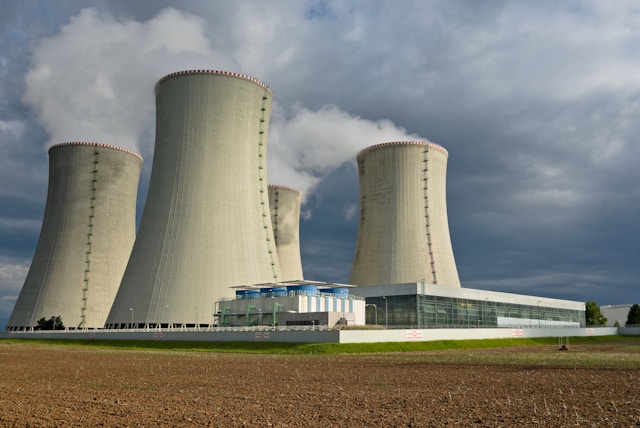Let’s talk jobs at Site C dam in Fort St. John

Most employees currently working at the Site C dam are heavy-equipment operators and entry-level skilled labourers. — Photo courtesy Jason Wilson, PRH
Most employees currently working at the Site C dam are heavy-equipment operators and entry-level skilled labourers. — Photo courtesy Jason Wilson, PRHP
The Site C Clean Energy Project introduced hundreds of job opportunities to the Peace River Regional District and the entire province of British Columbia. BC Hydro is building the third “Site C” dam and hydroelectric generating station along the Peace River that will provide clean electricity to about 450,000 homes each year in British Columbia. Construction began in 2015, and the planned completion date is 2024.
Two member-based organizations supporting work at the site, the Progressive Contractors Association of Canada (PCA) and the Christian Labour Association of Canada (CLAC), are excited about the job opportunities Site C has created for their respective members in British Columbia and will continue to provide in the years after construction.
The Progressive Contractors Association
A brief history lesson allows us to better understand the relationship between the PCA and CLAC, as well as their current roles at Site C.
The PCA approaches construction in a way that combats the monopolies previously prevalent in the industry. In the past, the construction industry firmly held two contrasting positions: unionized and divided based on craft versus non-union, which was often anti-union. The PCA in its partnership model with CLAC bridges the significant gap between the values of unionized and the non-union companies.
Not all the differences between these two groups are based in policies. “There were also huge differences in terms of labour mobility," said Paul de Jong, president of the PCA. "You didn’t see a lot of non-union workers temporarily working in the craft union environment or vice versa.
“There was a polarization in the industry,” de Jong said. Many workers and contractors wanted to create a fluid, mobile workforce that could meet the needs of any project. Many project owners were concerned that they weren’t receiving the best options during the bid tendering process.
A new approach was necessary. “What ended up happening over the past 20 years is the development of a third pillar in construction,” de Jong said, “an approach that recognizes the right of workers to organize, but also that of management to structure the work flexibly and productively.” The resulting model is a progressive approach to construction and engaging co-operative unions.
The PCA stresses that they are not anti-union, but anti-monopoly. “We pursue a construction industry that is fair and open for anybody, whether they are alternative union, non-union or traditional union,” said de Jong. Worker mobility, job opportunity and Canadian growth are the priorities. A positive relationship with their union employees is also a priority.
The Christian Labour Association of Canada
As an independent trade union, CLAC represents the interests of the employees working for PCA companies. “We believe that our collective agreements provide fair compensation and provide maximum mobility and career opportunities for our members,” said Josh Pastoor, Fort St. John regional director of CLAC. “They are not restricted like they would be in other unionized environments.”
In the case of Site C, the PCA represents Peace River Hydro Partners (PRHP), while CLAC ensures that agreements are respected for its workers.
Progressive solutions at Site C
Years earlier, following the PCA’s progressive model, BC Hydro questioned how to ensure the corporation found the best workers and the best companies to build the Site C Clean Energy Project. The result was a construction model that all qualified companies could bid on and that was an “open-managed” site. “In the present reality, we have a variety of labour models at play on Site C, giving BC Hydro and British Columbians the most vibrant opportunities for work and construction execution,” said de Jong.
By revamping its tendering model, BC Hydro found cost-conscious contractors. The company adopted an approach that focused on local employment and a flexible workforce.
One way that CLAC and the PCA work together is through promoting continued training and multiskilling among their members. The PCA working with CLAC allows for fluidity between skills, positions and job sites. PCA member companies value the opportunity to expand work opportunities for their CLAC employees. “You have an opportunity as an individual to be multiskilled,” said de Jong. “In this flexible approach, a scaffolder might also be trained as an insulator.”
The benefits of multiskilled workers
The shared promotion of multiskilling between PCA and CLAC allows their members to gain more skills for future employment, becoming more marketable, and offers increased job satisfaction. This is just one way that these two organizations break the restrictions of their industry.
“As a result of our innovative approach to construction, we are more productive,” de Jong said of his members and their CLAC employees on a job site. “We get things done increasingly on time, on target and on budget, so these projects are meeting their goals.”
The productivity is in part due to the dynamic crews comprised of multiskilled workers. “We make integrated crews of different skill sets. We can use these people as a team to focus on the work at hand as a dynamic team,” he said. The crews are tailored for specific projects versus managing individual crews of separated skill sets.
Training opportunities within the PCA and CLAC
Not only does the PCA and CLAC promote multiskilling, but they also offer training. “Our member companies support CLAC’s excellent training centre, which provides a range of options, whether it’s soft skills training or hard skills,” said de Jong. “There are safety courses, and technical courses for heavy-equipment operators.”
CLAC’s training opportunities cover a wider scope than that of typical unions. “Because we are multi-trade, we offer training bursaries, training funding and courses available to members no matter what individual trade they are in,” said Pastoor. “In the construction world, that sets us apart from the traditional model that the building trades union used, which is craft-based.” This opens more employment opportunities for their members, connecting them with a variety of contractors.
Training opportunities apply to current employees as well as incoming individuals. The PCA and CLAC work to give equal opportunities to women, recent graduates and First Nations communities. “Working with our labour partner, CLAC, our member companies support and provide job placements and mentoring, and financially support the CLAC training centre in British Columbia and other provinces to train the generation of tomorrow,” said de Jong. “Part of that generation is First Nations individuals who are training to become tomorrow’s electricians, equipment operators, labourers and carpenters.”
Site C job opportunities
Their inclusivity allows CLAC to represent employees across all trades at a given worksite. At Site C, about 850 of its members are working with the PCA Peace River Hydro Partners as skilled tradespeople, heavy-equipment operators, skilled labourers and entry-level labourers with the goal of moving into a skilled labourer role. “We understand that employment number is due to rise in the next year to about 1,000,” de Jong said.
As construction continues and the project transitions into operation, opportunities for electricians, heavy-duty mechanics and underground tunnellers should arise.
“Most are locals from the Peace River Regional District,” Pastoor said. However, many employees come from across British Columbia for the well-paying jobs. “Our prioritization working with CLAC is to ensure that as many opportunities are given to workers from British Columbia as possible,” de Jong said.
Negotiating terms for Site C CLAC workers
Part of representing the employees at Site C includes negotiating their terms. “Our collective agreement that we have negotiated with PRHP provides industry-leading wage rates in several classifications,” Pastoor said. He lists the highlights as: “The best health and welfare package in the construction industry in the province; retirement and pension plans negotiated in addition to their wages; provincial healthcare premium payments for BC residents; and funding from the employer for union member training initiatives.”
In the day-to-day business of Site C, CLAC advocates on behalf of its members to ensure that the agreement is followed and that health and safety is prioritized on site.
Overall, the PCA and CLAC work together to create a more robust and fluid workforce that is currently constructing a clean energy project that will benefit British Columbia for years to come. These organizations work together to inspire their members to reach greater outcomes on every job site.



